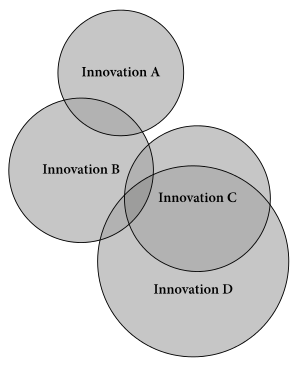波浪模型

历史语言学中,波浪模型或波模型、波理论(德語:Wellentheorie)是一种语言变化的模型,一种新的语言特征(创新)或创新的组合从其起源地区扩散开来,其影响的方言群随时间扩大。方言扩散从给定的接触点传播,就像水面上的波浪一样。[1]
该理论旨在替代树模型,后者似乎无法解释从祖语演化来时部分特征的存在,特别是在日耳曼语中。[2]20世纪,波浪模型作为整体语言变化的模型几乎没有获得接受,而在方言连续体和区域现象的领域引起关注;由于树模型的缺点,它最近在歷史語言學家中更受欢迎。[2][3]
原则
[编辑]树模型要求语言完全通过社会分裂和语言分歧来发展,一组方言发生的创新应立即导致它们与其他相关方言失去联系:这是解释树结构强加的子群嵌套组织的唯一方法。
波浪模型没有这样的要求,它可以很容易地适应交叉模式的创新分布。这是方言连续体的典型特征,即方言与不同邻居同时共享创新,其定义的谱系亚群形成交叉模式。这解释了波浪模型在方言学研究中的流行。[1]
约翰内斯·施密特认为,至少有一部分语言是从一个连续统一体中形成的。连续统一体起初就像一条平滑的斜线,距离相近的说话者倾向于统一其语言,在斜线的基础上形成一条阶梯线,这些阶梯就是方言。随时间推移,一些阶梯变薄并消失,另一些则抢占了整个连续体。例如施密特说标准德语,它就被定义为符合某些方言,然后传播到整个德国,在许多情况下取代了地方方言。
遗留
[编辑]现代语言学研究中,波浪模型通过比较法对改进树模型做出了巨大贡献。[4]甚至有学者提出,波模型应该代替树模型来表示语言谱系[2]。最近的研究也关注语链的概念,[5]也即一个从古方言连续体演变来的语言系属分类,且不能用树来表示,必须用波模型来分析。
应用
[编辑]波浪模型给语言学一些领域提供了关键的研究方法,如:
另见
[编辑]参考
[编辑]- ^ 1.0 1.1 Wolfram, Walt; Schilling-Estes, Natalie, Dialectology and Linguistic Diffusion (PDF), Joseph, Brian D.; Janda, Richard D. (编), The Handbook of Historical Linguistics, Oxford: Blackwell: 713–735, 2003 [2022-01-29], (原始内容 (PDF)存档于2021-11-10).
- ^ 2.0 2.1 2.2 François, Alexandre, Trees, Waves and Linkages: Models of Language Diversification (PDF), Bowern, Claire; Evans, Bethwyn (编), The Routledge Handbook of Historical Linguistics, London: Routledge: 161–189, 2014 [2022-01-29], ISBN 978-0-41552-789-7, (原始内容 (PDF)存档于2022-05-31).
- ^ Heggarty, Paul; Maguire, Warren; McMahon, April. Splits or waves? Trees or webs? How divergence measures and network analysis can unravel language histories. Philosophical Transactions of the Royal Society B. 2010, 365 (1559): 3829–3843. PMC 2981917
 . PMID 21041208. doi:10.1098/rstb.2010.0099..
. PMID 21041208. doi:10.1098/rstb.2010.0099..
- ^ Labov, William. Transmission and diffusion. Language. 2007, 83 (2): 344–387. doi:10.1353/lan.2007.0082.
- ^ "I use the term linkage to refer to a group of communalects [i.e. dialects or languages] which have arisen by dialect differentiation" Ross, Malcolm D. Proto Oceanic and the Austronesian languages of Western Melanesia. Canberra: Pacific Linguistics. 1988: 8.
| ||||||||||||||||||||||||||||||||
Text is available under the CC BY-SA 4.0 license; additional terms may apply.
Images, videos and audio are available under their respective licenses.
